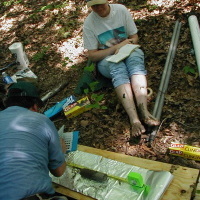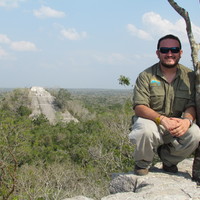Publications by Marcelo F Napoli

The east coast of Brazil comprises an extensive area inserted in the Tropical Atlantic Domain and... more The east coast of Brazil comprises an extensive area inserted in the Tropical Atlantic Domain and is represented by sandy plains of beach ridges commonly known as Restingas.
The coastal environments are unique and house a rich amphibian fauna, the geographical distribution patterns of which are incipient. Biogeographical studies can explain the current distributional patterns and provide the identification of natural biogeographical units. These areas are important in elucidating the evolutionary history of the taxa and the areas where they occur. The aim of this study was to seek natural biogeographical units in the Brazilian sandy plains of beach ridges by means of distribution data of amphibians and to test the main predictions of the vicariance model to explain the patterns found. We revised and georeferenced data on the geographical distribution of 63 anuran species. We performed a
search for latitudinal distribution patterns along the sandy coastal plains of Brazil using the non-metric multidimensional scaling method (NMDS) and the biotic element analysis to
identify natural biogeographical units. The results showed a monotonic variation in anuran species composition along the latitudinal gradient with a break in the clinal pattern from
23°S to 25°S latitude (states of Rio de Janeiro to São Paulo). The major predictions of the vicariance model were corroborated by the detection of four biotic elements with significantly
clustered distribution and by the presence of congeneric species distributed in distinct biotic elements. The results support the hypothesis that vicariance could be one of the factors responsible for the distribution patterns of the anuran communities along the sandy coastal plains of eastern Brazil. The results of the clusters are also congruent with the predictions of paleoclimatic models made for the Last Glacial Maximum of the Pleistocene, such as the presence of historical forest refugia and biogeographical patterns already detected for amphibians in the Atlantic Rainforest.

A central issue for ecologists is to understand the variables that determine species distribution... more A central issue for ecologists is to understand the variables that determine species distribution. Many studies have suggested that environmental variables are the main factors that shape anuran communities. Nevertheless, several natural environments have not been assessed with ecological studies of this nature, including specific ecosystems of the South American Cerrado morphoclimatic domain. In the
present study, we investigated the relationship between environmental variables and the spatial distribution of anurans in ecosystems of semi-deciduous and riparian forests in a transitional region between the Cerrado and Caatinga environments in the western Bahia state, Brazil.
We collected fauna and environmental variables data in 10 sampling units during two rainy periods. The original information on species composition and abundance in the community was reduced to a single axis using a non-metric multidimensional scaling method (NMDS) and environmental data were reduced to two main factors using a principal component analysis (PCA). We tested the absence of an association between the structural variation of the environment and spatial distribution of the anuran community using a multiple regression analysis. The anuran community was ordered following a gradient of dry semi-deciduous seasonal areas toward riparian forest with areas of direct insolation and lentic water bodies. Among the components extracted by the PCA, only PC1 was associated with anuran community composition, explaining 69% of the ordination obtained by the NMDS according to variables related to the presence of water bodies. The great contribution of water bodies appears to reflect the degree of modification of the landscape in the region and seasonal restrictions in the availability of water, with both aspects increasing the expected influence of water bodies on the distribution of anurans in the western Bahia state. Future investigations exploring the structure of anurofauna during dry seasons could extend and complement the results provided by this study.

Herpetologica, Dec 1, 2007
Most studies of amphibian communities are restricted to aquatic environments, which
precludes so... more Most studies of amphibian communities are restricted to aquatic environments, which
precludes sound descriptions of changes in composition throughout entire habitats. Moreover, few works focus on the environmental processes that shape the composition of these communities, particularly in tropical ecosystems. In this study, we investigated which environmental variables were able to predict the main changes in anuran community composition in a shrub-to-forest Restinga on the northeastern coastline of Bahia State, Brazil. In 30 plots (60 3 25 m) along a continuous Restinga area, we determined, over two consecutive rainy seasons, the abundances of anuran species and 20 primary environmental variables. We represented the main environmental gradients of the Restinga using the first axes derived from a principal component analysis (PCA) of the matrix of environmental variables. We represented the main changes in community composition using a synthetic axis built by applying the nonmetric multidimensional scaling technique (NMS) on the matrix of species abundances. We then evaluated, using a multiple linear regression test, which environmental gradients, if any, were able to explain changes in community composition. We
recorded 737 anurans, belonging to 8 families, 17 genera, and 30 species. Five orthogonal environmental gradients were extracted, representing ca. 80% of the variance of the matrix of environmental variables; the first PC represented the covariation among the amount of leaves in the stratum from 6 to 10 m high, percentage of leaf litter, percentage of terrestrial bromeliads with direct sunlight, number of terrestrial bromeliads, and soil moisture. The NMS axis explained 50% of the variance of the abundance matrix and ordered the plots through the sequence (1) beach zone, (2) arboreal vegetation with temporary ponds and/or
permanent lakes, (3) arboreal vegetation with rivers or streams, and (4) arboreal vegetation without bodies of water. Only PC1, which represented a shrub-to-forest gradient, was significantly related to the NMS axis. The change on plant communities, allied to soil moisture and type of water body, was the most important environmental factor acting on the structure of the anuran community herein studied.

Phyllomedusa: Journal of …, Jan 1, 2011
The Brazilian Ministry of the Environment (Ministe´ rio Do Meio Ambiente, MMA) proposed
defining... more The Brazilian Ministry of the Environment (Ministe´ rio Do Meio Ambiente, MMA) proposed
defining priority areas for Brazilian biodiversity conservation in 2007, but to date, no definitions of priority areas for amphibian conservation have been developed for the Caatinga biome or the semiarid region of Brazil. In this study, we searched for ‘‘hot spots’’ of amphibians in these two regions and assessed whether the priority areas established by the MMA coincided with those suitable for amphibian conservation. We determined amphibian hot spots by means of three estimates: areas of endemism, areas of high species richness, and areas with species that are threatened, rare, or have very limited distributions. We then assessed the degree of coincidence between amphibian hot spots and the priority areas of the MMA based on the current conservation units. We analyzed areas of endemism with the use of a parsimony analysis of
endemicity (PAE) on quadrats. The Caatinga biome and semiarid region showed four and six areas of endemism, respectively, mainly associated with mountainous areas that are covered by isolated forests and positively correlated with species richness. All areas of endemism coincided with one or more priority areas defined by the MMA. We identify 15 priority areas for amphibian conservation in the Caatinga biome and semiarid region, including the creation of new full-protection conservation units.

Herpetologica, Jan 1, 2012
The Brazilian Ministry of the Environment (Ministe´ rio Do Meio Ambiente, MMA) proposed defining ... more The Brazilian Ministry of the Environment (Ministe´ rio Do Meio Ambiente, MMA) proposed defining priority areas for Brazilian biodiversity conservation in 2007, but to date, no definitions of priority areas for amphibian conservation have been developed for the Caatinga biome or the semiarid region of Brazil. In this study, we searched for ‘‘hot spots’’ of amphibians in these two regions and assessed whether the priority areas established by the MMA coincided with those suitable for amphibian conservation. We determined amphibian hot spots by means of three estimates: areas of endemism, areas of high species richness, and areas with species that are threatened, rare, or have very limited distributions. We then assessed the degree of coincidence between amphibian hot spots and the priority areas of the MMA based on the current conservation units. We analyzed areas of endemism with the use of a parsimony analysis of endemicity (PAE) on quadrats. The Caatinga biome and semiarid region showed four and six areas of endemism, respectively, mainly associated with mountainous areas that are covered by isolated forests and positively correlated with species richness. All areas of endemism coincided with one or more priority areas defined by the MMA. We identify 15 priority areas for amphibian conservation in the Caatinga biome and semiarid region, including the creation of new full-protection conservation units.

Amphibians experiencing evapotranspirative water loss may suffer dehydration. Another difficulty ... more Amphibians experiencing evapotranspirative water loss may suffer dehydration. Another difficulty is their limited tolerance to brackish water. This study aimed to investigate the effect of water salinity on behavior (activity and water conservation posture) in Leptodactylus macrosternum, in normally hydrated animals with urine in their bladder, in normally hydrated animals without urine in their bladder and in dehydrated ones with urine removed from their bladder. Experiments were filmed, behaviors were registered, and a Behavioral Dehydration Protection Index (BDPI) was calculated, using a weighted average of the postures. A GLM and Kruskall Wallis test was performed with Dunn’s multiple comparisons test to evaluate the effects of osmotic gradient stress on BDPI. It was found that emptied bladder and aerial dehydration did not influence BDPI (p = 0.832 and p = 0.142, respectively), contrary to what is seen in the literature. The different osmotic media had a significant effect on BDPI (p = 0.0003).
South American Journal of Herpetology, 2007
A new species of the genus Chiasmocleis is described from the Reserva Sapiranga, an Atlantic Rain... more A new species of the genus Chiasmocleis is described from the Reserva Sapiranga, an Atlantic Rain Forest remnant in the Municipality of Mata de São João, northeastern State of Bahia, Brazil. This species belongs to the C. leucosticta group, charac- terized by well-developed webbing on feet. Chiasmocleis sapiranga sp. nov. is diagnosed by having the fingers extensively fringed in males

Copeia
We describe a new species of tree frog related to the Bokermannohyla circumdata group, the northe... more We describe a new species of tree frog related to the Bokermannohyla circumdata group, the northernmost record from Atlantic Forest remnants In eastern Bahia, northeastern Brazil, within regions known as Vale do Jiquirica, Baixo Sul, and Litoral Sul. The new species is diagnosed by medium size (snout-vent length 46.8-64.1 mm), head longer than wide, small tympanum, posterior surfaces of thighs with dark brown transverse stripes without additional thin stripes between them, vocal slits in adult males, and distinct advertisement call with a single note composed of 30-110 pulses distributed within 2-9 pulse groups, similar to the bleating of a goat. The new species Is morphologically similar to B. hylax and B. lucianae, but is readily distinguished by the presence of barred posterior surfaces on the thighs without thin stripes between them (immaculate in B. lucianae, thin stripes intercalated with wider stripes In B. hylax) and by Its distinct vocalization.

The taxonomic and biogeographic affinities of Strabomantis aramunha from the Campos Rupestres of ... more The taxonomic and biogeographic affinities of Strabomantis aramunha from the Campos Rupestres of Brazil are intriguing. A unique skull morphology of females suggest affinities with the broad-headed eleutherodactylines of Northwestern South America in the genus Strabomantis. Male and juvenile morphology nonetheless suggest S. aramunha could be related to members of the recently described genus Haddadus from eastern Brazil. We assess the affinities of S. aramunha using molecular phylogenetic analyses of mitochondrial (12S, tRNAval, 16S, cyt b) and nuclear sequences (RAG-1and rhodopsin). Bayesian inference, likelihood, and parsimony analysis recover a highly supported clade with S. aramunha and H. binotatus as sister taxa. Accordingly, we transfer S. aramunha to Haddadus, and provide a new generic definition of the later. The distribution of species in Haddadus (highlands of the Espinhaço mountain Range and coastal eastern Brazil) is now concordant with the general pattern observed for other species in the area.
The Dendropsophus decipiens species group, placed in the D. microcephalus species clade, comprise... more The Dendropsophus decipiens species group, placed in the D. microcephalus species clade, comprises D. decipiens, D. berthalutzae, D. oliveirai and D. haddadi, which have their larvae already described in the literature. In this account, we describe the variation of the tadpole of D. haddadi from the Municipality of Mata de São João, State of Bahia, Brazil. We also compare this tadpole to the larvae of the D. decipiens and D. microcephalus species groups already described.
herpetologynotes.seh-herpetology. …
Arquivos do …, Jan 1, 2006
South American Journal of …, Jan 1, 2009
Arquivos do Museu Nacional, Jan 1, 2003
Arquivos do Museu Nacional, Jan 1, 2005











Uploads
Publications by Marcelo F Napoli
The coastal environments are unique and house a rich amphibian fauna, the geographical distribution patterns of which are incipient. Biogeographical studies can explain the current distributional patterns and provide the identification of natural biogeographical units. These areas are important in elucidating the evolutionary history of the taxa and the areas where they occur. The aim of this study was to seek natural biogeographical units in the Brazilian sandy plains of beach ridges by means of distribution data of amphibians and to test the main predictions of the vicariance model to explain the patterns found. We revised and georeferenced data on the geographical distribution of 63 anuran species. We performed a
search for latitudinal distribution patterns along the sandy coastal plains of Brazil using the non-metric multidimensional scaling method (NMDS) and the biotic element analysis to
identify natural biogeographical units. The results showed a monotonic variation in anuran species composition along the latitudinal gradient with a break in the clinal pattern from
23°S to 25°S latitude (states of Rio de Janeiro to São Paulo). The major predictions of the vicariance model were corroborated by the detection of four biotic elements with significantly
clustered distribution and by the presence of congeneric species distributed in distinct biotic elements. The results support the hypothesis that vicariance could be one of the factors responsible for the distribution patterns of the anuran communities along the sandy coastal plains of eastern Brazil. The results of the clusters are also congruent with the predictions of paleoclimatic models made for the Last Glacial Maximum of the Pleistocene, such as the presence of historical forest refugia and biogeographical patterns already detected for amphibians in the Atlantic Rainforest.
present study, we investigated the relationship between environmental variables and the spatial distribution of anurans in ecosystems of semi-deciduous and riparian forests in a transitional region between the Cerrado and Caatinga environments in the western Bahia state, Brazil.
We collected fauna and environmental variables data in 10 sampling units during two rainy periods. The original information on species composition and abundance in the community was reduced to a single axis using a non-metric multidimensional scaling method (NMDS) and environmental data were reduced to two main factors using a principal component analysis (PCA). We tested the absence of an association between the structural variation of the environment and spatial distribution of the anuran community using a multiple regression analysis. The anuran community was ordered following a gradient of dry semi-deciduous seasonal areas toward riparian forest with areas of direct insolation and lentic water bodies. Among the components extracted by the PCA, only PC1 was associated with anuran community composition, explaining 69% of the ordination obtained by the NMDS according to variables related to the presence of water bodies. The great contribution of water bodies appears to reflect the degree of modification of the landscape in the region and seasonal restrictions in the availability of water, with both aspects increasing the expected influence of water bodies on the distribution of anurans in the western Bahia state. Future investigations exploring the structure of anurofauna during dry seasons could extend and complement the results provided by this study.
precludes sound descriptions of changes in composition throughout entire habitats. Moreover, few works focus on the environmental processes that shape the composition of these communities, particularly in tropical ecosystems. In this study, we investigated which environmental variables were able to predict the main changes in anuran community composition in a shrub-to-forest Restinga on the northeastern coastline of Bahia State, Brazil. In 30 plots (60 3 25 m) along a continuous Restinga area, we determined, over two consecutive rainy seasons, the abundances of anuran species and 20 primary environmental variables. We represented the main environmental gradients of the Restinga using the first axes derived from a principal component analysis (PCA) of the matrix of environmental variables. We represented the main changes in community composition using a synthetic axis built by applying the nonmetric multidimensional scaling technique (NMS) on the matrix of species abundances. We then evaluated, using a multiple linear regression test, which environmental gradients, if any, were able to explain changes in community composition. We
recorded 737 anurans, belonging to 8 families, 17 genera, and 30 species. Five orthogonal environmental gradients were extracted, representing ca. 80% of the variance of the matrix of environmental variables; the first PC represented the covariation among the amount of leaves in the stratum from 6 to 10 m high, percentage of leaf litter, percentage of terrestrial bromeliads with direct sunlight, number of terrestrial bromeliads, and soil moisture. The NMS axis explained 50% of the variance of the abundance matrix and ordered the plots through the sequence (1) beach zone, (2) arboreal vegetation with temporary ponds and/or
permanent lakes, (3) arboreal vegetation with rivers or streams, and (4) arboreal vegetation without bodies of water. Only PC1, which represented a shrub-to-forest gradient, was significantly related to the NMS axis. The change on plant communities, allied to soil moisture and type of water body, was the most important environmental factor acting on the structure of the anuran community herein studied.
defining priority areas for Brazilian biodiversity conservation in 2007, but to date, no definitions of priority areas for amphibian conservation have been developed for the Caatinga biome or the semiarid region of Brazil. In this study, we searched for ‘‘hot spots’’ of amphibians in these two regions and assessed whether the priority areas established by the MMA coincided with those suitable for amphibian conservation. We determined amphibian hot spots by means of three estimates: areas of endemism, areas of high species richness, and areas with species that are threatened, rare, or have very limited distributions. We then assessed the degree of coincidence between amphibian hot spots and the priority areas of the MMA based on the current conservation units. We analyzed areas of endemism with the use of a parsimony analysis of
endemicity (PAE) on quadrats. The Caatinga biome and semiarid region showed four and six areas of endemism, respectively, mainly associated with mountainous areas that are covered by isolated forests and positively correlated with species richness. All areas of endemism coincided with one or more priority areas defined by the MMA. We identify 15 priority areas for amphibian conservation in the Caatinga biome and semiarid region, including the creation of new full-protection conservation units.
The coastal environments are unique and house a rich amphibian fauna, the geographical distribution patterns of which are incipient. Biogeographical studies can explain the current distributional patterns and provide the identification of natural biogeographical units. These areas are important in elucidating the evolutionary history of the taxa and the areas where they occur. The aim of this study was to seek natural biogeographical units in the Brazilian sandy plains of beach ridges by means of distribution data of amphibians and to test the main predictions of the vicariance model to explain the patterns found. We revised and georeferenced data on the geographical distribution of 63 anuran species. We performed a
search for latitudinal distribution patterns along the sandy coastal plains of Brazil using the non-metric multidimensional scaling method (NMDS) and the biotic element analysis to
identify natural biogeographical units. The results showed a monotonic variation in anuran species composition along the latitudinal gradient with a break in the clinal pattern from
23°S to 25°S latitude (states of Rio de Janeiro to São Paulo). The major predictions of the vicariance model were corroborated by the detection of four biotic elements with significantly
clustered distribution and by the presence of congeneric species distributed in distinct biotic elements. The results support the hypothesis that vicariance could be one of the factors responsible for the distribution patterns of the anuran communities along the sandy coastal plains of eastern Brazil. The results of the clusters are also congruent with the predictions of paleoclimatic models made for the Last Glacial Maximum of the Pleistocene, such as the presence of historical forest refugia and biogeographical patterns already detected for amphibians in the Atlantic Rainforest.
present study, we investigated the relationship between environmental variables and the spatial distribution of anurans in ecosystems of semi-deciduous and riparian forests in a transitional region between the Cerrado and Caatinga environments in the western Bahia state, Brazil.
We collected fauna and environmental variables data in 10 sampling units during two rainy periods. The original information on species composition and abundance in the community was reduced to a single axis using a non-metric multidimensional scaling method (NMDS) and environmental data were reduced to two main factors using a principal component analysis (PCA). We tested the absence of an association between the structural variation of the environment and spatial distribution of the anuran community using a multiple regression analysis. The anuran community was ordered following a gradient of dry semi-deciduous seasonal areas toward riparian forest with areas of direct insolation and lentic water bodies. Among the components extracted by the PCA, only PC1 was associated with anuran community composition, explaining 69% of the ordination obtained by the NMDS according to variables related to the presence of water bodies. The great contribution of water bodies appears to reflect the degree of modification of the landscape in the region and seasonal restrictions in the availability of water, with both aspects increasing the expected influence of water bodies on the distribution of anurans in the western Bahia state. Future investigations exploring the structure of anurofauna during dry seasons could extend and complement the results provided by this study.
precludes sound descriptions of changes in composition throughout entire habitats. Moreover, few works focus on the environmental processes that shape the composition of these communities, particularly in tropical ecosystems. In this study, we investigated which environmental variables were able to predict the main changes in anuran community composition in a shrub-to-forest Restinga on the northeastern coastline of Bahia State, Brazil. In 30 plots (60 3 25 m) along a continuous Restinga area, we determined, over two consecutive rainy seasons, the abundances of anuran species and 20 primary environmental variables. We represented the main environmental gradients of the Restinga using the first axes derived from a principal component analysis (PCA) of the matrix of environmental variables. We represented the main changes in community composition using a synthetic axis built by applying the nonmetric multidimensional scaling technique (NMS) on the matrix of species abundances. We then evaluated, using a multiple linear regression test, which environmental gradients, if any, were able to explain changes in community composition. We
recorded 737 anurans, belonging to 8 families, 17 genera, and 30 species. Five orthogonal environmental gradients were extracted, representing ca. 80% of the variance of the matrix of environmental variables; the first PC represented the covariation among the amount of leaves in the stratum from 6 to 10 m high, percentage of leaf litter, percentage of terrestrial bromeliads with direct sunlight, number of terrestrial bromeliads, and soil moisture. The NMS axis explained 50% of the variance of the abundance matrix and ordered the plots through the sequence (1) beach zone, (2) arboreal vegetation with temporary ponds and/or
permanent lakes, (3) arboreal vegetation with rivers or streams, and (4) arboreal vegetation without bodies of water. Only PC1, which represented a shrub-to-forest gradient, was significantly related to the NMS axis. The change on plant communities, allied to soil moisture and type of water body, was the most important environmental factor acting on the structure of the anuran community herein studied.
defining priority areas for Brazilian biodiversity conservation in 2007, but to date, no definitions of priority areas for amphibian conservation have been developed for the Caatinga biome or the semiarid region of Brazil. In this study, we searched for ‘‘hot spots’’ of amphibians in these two regions and assessed whether the priority areas established by the MMA coincided with those suitable for amphibian conservation. We determined amphibian hot spots by means of three estimates: areas of endemism, areas of high species richness, and areas with species that are threatened, rare, or have very limited distributions. We then assessed the degree of coincidence between amphibian hot spots and the priority areas of the MMA based on the current conservation units. We analyzed areas of endemism with the use of a parsimony analysis of
endemicity (PAE) on quadrats. The Caatinga biome and semiarid region showed four and six areas of endemism, respectively, mainly associated with mountainous areas that are covered by isolated forests and positively correlated with species richness. All areas of endemism coincided with one or more priority areas defined by the MMA. We identify 15 priority areas for amphibian conservation in the Caatinga biome and semiarid region, including the creation of new full-protection conservation units.
Key words: Amphibia, Faunistics, Restinga, Tropical Atlantic Forest.
O Livro pode ser baixado na íntegra em: http://repositorio.ufba.br/ri/handle/ri/24288